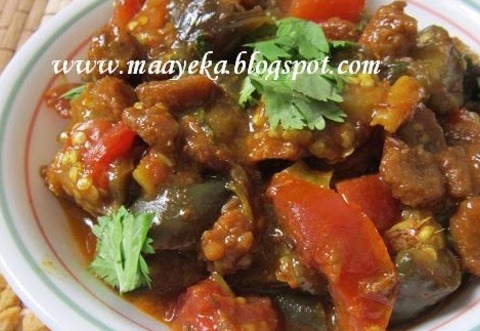#brinjal curry
Text
Begun
#veg curry#tasty#cooking#food#delicious#tastyrecipes#tasty food#brinjal curry#vegetarian#vegan#food porn#connecttofood#2024
0 notes
Video
youtube
Village Food Best Easy Cooking Foli Fish Brinjal Recipe বেগুন নতুন পেঁয়...
0 notes
Text
My Lunch Box came with a piece of brinjal (eggplant or aubergine) sandwiched with mined pork, deep-fried then stewed. Also in are curry chicken & potato plus stir-fried Chinese cabbage over white rice.

#Economy Rice#菜饭#Cai Png#Brinjal#Eggplant#Aubergine#Minced Pork#Curry Chicken#Potato#Spicy#Chinese Cabbage#Vegetables#White Rice#Takeaway#Packed#Brunch#Asian Food#Food#Buffetlicious
81 notes
·
View notes
Text
I love liquid or semi-liquid foods that taste more delicious the next day. ofc soups and broths and stews and curries and rassams and usals and all similar iterations but also chili and pav bhaji and even bharit
#A mutual has been posting about chili and it made me think about kheema and pav bhaji#and how all such gravy-ed foods taste so much better the next day as the ingredients get to soak in the liquid#Not soak but I can't remember the culinary term for 'murne'. marinate? stew?#Vangyache bharit (baingan bharta) also tastes so good the next day#I mean. it has garlic and brinjal - match made in heaven#I don't even need to say anything about any rassa or amti or usal everyone knows day-old curry is the best#Now I'm craving pav bhaji. or kheema pav. or misal pav. anything with bread really#food
16 notes
·
View notes
Text
Brinjal With Garlic Chili | Vankaya Velluli Karam
New Post has been published on https://www.hyderabadiruchulu.com/brinjal-with-garlic-chili/
Brinjal With Garlic Chili | Vankaya Velluli Karam

Print
Brinjal with Garlic Chili
Prep Time
20 mins
Cook Time
15 mins
Welcome to Hyderabadi Ruchulu, where we explore delightful culinary creations. Today, let's delve into the art of preparing Brinjal with garlic chili or vankaya velluli karam—a combination that tantalizes the taste buds with its spicy allure, particularly appealing to aficionados of brinjal.
Course: Dinner, Lunch
Cuisine: Indian
Keyword: Brinjal With Garlic Chili, Eggplant Recipes, Vankaya Recipes
Servings: 4 people
Ingredients
1/4 kg Brinjals
12-14 Garlic Cloves
1/4 cup Curry Leaves
1 tsp Cumin Seeds
1 1/2 tsp Chili Powder
1/4 tsp Turmeric Powder
1/4 cup Coriander Leaves
Salt
3 tbsp Oil
Instructions
For this delectable recipe, you'll need 1/4 kg of brinjals. Begin by making vertical cuts in them, dividing the brinjals into four parts, reminiscent of the technique used for gutti vankaya or masala-stuffed brinjal.
To ensure the brinjals maintain their freshness and color, immerse the cut pieces in salt-water, preventing them from turning brown during the preparation process.
Now, let's move on to the cooking process. Heat 3 tbsp of oil in a pan and carefully add the cut brinjals. Fry them, flipping intermittently, over a low flame until they are thoroughly cooked on all sides.
As the brinjals sizzle to perfection, let's craft the garlic chili paste. In a mixer jar, combine garlic cloves, 1 tsp cumin seeds, salt to taste, 1 1/2 tsp chili powder, and 1/4 cup curry leaves. Grind these ingredients into a flavorful paste.
Transfer the prepared garlic chili masala to a pan, add a dash of water and 1/4 tsp of turmeric powder, and cook for a minute.
Integrate the cooked brinjals into this aromatic blend, stirring them gently. Close the lid and let the concoction simmer over low heat for 3-4 minutes.
As the oil begins to float on the surface, garnish the dish with a sprinkling of fresh coriander leaves. Finally, cut off the stove.
This mouthwatering brinjal with garlic chili creation is now ready to be savored. Pair it with rice or roti for a wholesome and satisfying meal. Thank you for joining us at Hyderabadi Ruchulu—where every dish tells a tale of flavorsome finesse.
#brinjal chili garlic recipe#brinjal garlic chili recipe#brinjal recipes#chepathi curry#chili garlic recipes#chilli garlic recipe#easy vegetable curry#eggplant recipes#eggplant with garlic chili#garlic chili recipes#Hyderabadi Ruchulu#indira ireni#spicy vegetable curry
0 notes
Text
Kathirikai Curry Brinjal in Tamarind sauce

0 notes
Video
youtube
వంకాయ ఆలుగడ్డ కూర # vankaya aalugadda curry# bringal potta curry
0 notes
Text
Brinjal Gravy (Kathirikkai Gravy / Kuzhambu) Recipe in Tamil
youtube
#Brinjal#Gravy#Kathirikai#Kathirikkai#Kulambu#Kuzhambu#biryani#sidedish#biryanigravy#biryanisidedish#maincourse#lunch#dinner#breakfast#curry#brinjalcurry#food#recipe#vegetarian#vegan#northindianfood#southindian#biriyani#yummy#taste#tasty#hot#spice#fried#spicyfood
1 note
·
View note
Text
youtube
Dahi Baingan| दही बैगन | Bringal Curd Curry
0 notes
Text
Brinjal curry for Biryani - Recipe in pics
Also in the blog now:
Spices – A picTip of the day – Avoid spilling of boiling liquidCurd rice, kovaikai poriyal, potato roast -Perfect lunch Feb 13 2023Easy Baguettes- recipe pics
Check out my Instagram profile and highlights for more pics and recipes – @Fhareena #parveenskitchen #foodblogger

View On WordPress
0 notes
Video
youtube
Kumra Bore Begun Tomato Diye Deshi Magur Macher Jhol Ranna Brinjal Tomat...
0 notes
Text
Hyderabadi Baingan (Eggplants Hyderabad Style)
Having peanuts, coconut and tamarind, this dish has a unique flavor profile. A must try for all eggplant lovers.
I love the texture and flavors that the peanuts and coconut add to the curry. A must try for all eggplant lovers.
I got introduced to hyderabadi baingan through my mother-in-law. Having some unusual ingredients like peanuts, coconut and tamarind, these eggplants have a unique flavor profile. I really liked it and asked her for the recipe.
Ingredients At a Glance
Notes:
All of the ingredients…
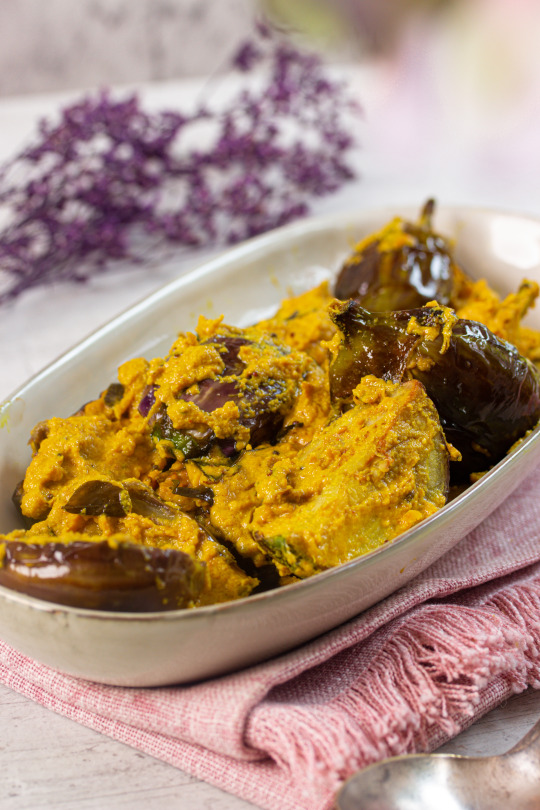
View On WordPress
#aubergines#aubergines curry#aubergines indian recipe#aubergines recipe#baingan recipe#baingan sabzi#brinjal recipe#eggplant curry#eggplants#eggplants Indian recipe#eggplants recipe#indian vegetarian food#indian vegetarian recipes#indisch vegetarisch rezept#vegetarisch rezept
1 note
·
View note
Text
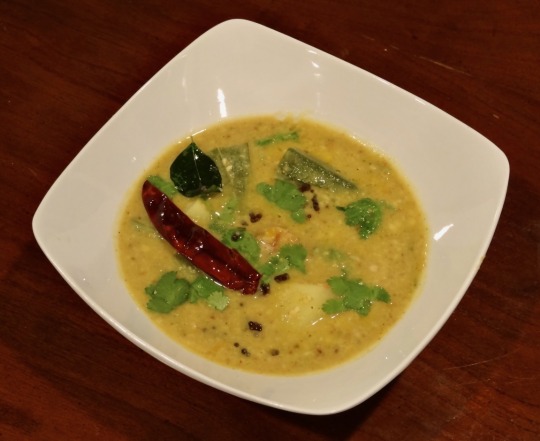
[ID: A bowl of a bright yellow stew topped with cilantro, mustard seed, chili, and curry leaf. End ID]
ಉಡುಪಿ ಸಾಂಬಾರ್ / Udupi sambar
A sambar is a lentil-and-vegetable stew distinguished by the use of a particular spice blend (Hindi: सांबर मसाला "sāmbār masālā," "sambar spice"; Kannada: ಸಾಂಬಾರ್ ಪುಡಿ "sāmbār puḍi," "sambar powder"). Sambars are a staple of South Indian and Sri Lankan cooking, sometimes made in households for multiple meals a week. The word "sambar" can be traced back to the Sanskrit सम्भार "sambhārá," "collection of things required for a particular purpose”; “spices."
The lentil used in sambar dishes is usually tur dal (split pigeon peas), though arhar dal, tuvur dal, or even blends containing masur or mung dal may be used, depending on the cook or the region. Vegetables also vary between combinations of okra, potato, ash gourd (petha), bottle gourd (doodhi / lauki), drumstick (saijan ki phalli), beetroot, tomato, carrot, pumpkin, brinjal, and pearl onions, among others. The sambar masala fries chilis, curry leaves, dal, and various spices including cumin, coriander, and fenugreek, then grinds them into a spicy, earthy, fragrant blend.
This recipe makes a sambar in the style of ಉಡುಪಿ (Udupi) cuisine—a subdivision of the cuisine of the ತುಳುವ (Tuluva) people localised in the Udupi District of Karnataka, a southeastern coastal state of India. (Tuluva cuisine is also commonly found in Dakshina Kannada, Karnataka, and Kasaragod, Kerala). In the Udupi region, sambar may be known as "ಕೊಡೆಲ್" "kodhel"; perhaps related to "ಕಡಲೆ" "kadhale" "Bengal gram"; or "ಹುಲಿ" "huḷi"; "tartness." Udupi huli has coconut oil and jaggery as its primary distinguishing features: the jaggery's deep sweetness and the earthy pungency of unrefined coconut oil combine with the spice of the chilis and the sour fruitiness of the tamarind to create a complex, flavorful, well-balanced dish.
Udupi huli may be further divided into a few major types. ಮಸಾಲೆ ಹುಳಿ ("masāla huḷi") contains shredded coconut and vegetables; ಬೋಳು ಹುಳಿ ("bolu huḷi") contains vegetables, but omits the coconut.
Hotel-style masala huli recipes typically add a lot of jaggery to produce a distinct sweetness; cut back on the amount of coconut included; and contain onion and garlic. The other main type of masala huli—“temple style”—is sattvic (from Sanskrit "सत्त्व" "sattva": "goodness," "essence," "existence"), which in this context means that onions and garlic are excluded.
A sattvic diet in Hinduism centres around the concept of maintaining sattva by eating only pure and mild (sattvic) foods, and omitting tamasic (“dark,” "inert," "destructive"; from Sanskrit तमस् "tamas") and rajasic ("exciting," "passionate," from Sanskrit रजस् "rajas") ones. The concepts of sattva, tamas, and rajas (the गुण "guṇa" system) are central to the construction of caste: the degree to which each person innately inherits each quality supposedly determines their possession of characteristics including honesty, intelligence, and goodness (sattva), stupidity and lack of creativity (tamas), and passion and pridefulness (rajas); the possession of these characteristics in turn determines their rightful place in a professional and social hierarchy. The association of certain foods with certain qualities thus links diet to caste: a distinction in diet is one of the methods by which those belonging to upper castes maintain and police caste boundaries.
This recipe makes enough pudi for one pot of sambar. Traditionally, sambar pudi is created fresh each time the dish is made, but many households make large batches and store them. In this case, omit the coconut; or, use dried coconut and store the masala in the refrigerator.
Recipe under the cut!
Patreon | Paypal | Venmo
Ingredients:
Serves 4-6.
For the sambar:
2 cups chopped vegetables
1 red onion, sliced*
1 cup (200g) yellow split pigeon peas / tur dal / ತೂರ್ ದಾಲ್ (ಹಳದಿ ಸ್ಪ್ಲಿಟ್ ಪಾರಿವಾಳದ ಬಟಾಣಿ)
4 cups (1 litre) water, or as needed
1/4 tsp ground turmeric / haldi / ಅರಿಶಿನ
2 tsp table salt
2 tsp jaggery / gur / ಬೆಲ್ಲ*
1/4 cup (60mL) tamarind pulp (from 1 Tbsp dried tamarind / imlie / ಹುಣಸೆಹಣ್ಣು)
2 tsp unrefined coconut oil / nariyal ka tel / ತೆಂಗಿನ ಎಣ್ಣೆ
Ingredient list format is English / Hindi (Latin transcription) / Kannada. The Hindi is provided for convenience while shopping.
Udupi sambar usually uses any of: gourd, brinjal (Indian eggplant), pumpkin, dumstick (saijan ki phalli), and okra. Pearl onion is not usually used in this region, but you can add whatever you want, according to taste.
*For a hotel-style sambar, include the onion; increase the jaggery to 2 Tbsp.
For the spice paste / sambar masala / ಸಾಂಬಾರ್ ಪುಡಿ ("sambar pudi"):
1/2 Tbsp split Bengal gram / chana dal / ಹಳದಿ ಸ್ಪ್ಲಿಟ್ ಗ್ರಾಂ
2 tsp split black gram / urad dal chilka / ಸ್ಪ್ಲಿಟ್ ಬ್ಲ್ಯಾಕ್ ಗ್ರಾಂ
2 tsp coriander seeds / dhaniya / ಕೊತ್ತಂಬರಿ ಬೀಜದ
1/2 tsp fenugreek seeds / methi / ಮೆಂತ್ಯ
1 tsp cumin seeds / jeera / ಜೀರಿಗೆ
1 tsp ground turmeric
5-6 curry leaves / kari pati / ಕರಿಬೇವು
3-4 Byadagi or other dried red chilis / byadagi mirch / ಬ್ಯಾಡಗಿ ಮೆಣಸಿನಕಾಯಿ
4 cloves garlic, skins on*
Large pinch asafoetida / hing / ಇಂಗು
1 cup (100g) fresh coconut (about one coconut)*
1/2 cup (120mL) water
While the ratio of ingredients in Udupi sambar pudi vary slightly, the ingredients themselves are almost always consistent.
*For a hotel-style sambar, include the garlic, and decrease the coconut in the sambar masala to 1/4 or 1/2 cup (25-50g).
The grams and pulses in this pudi have many different names. You can find them in a halal or South Asian grocery store; look on the bag for the Hindi names (since they have been transcribed into Latin, the spelling may vary from what you see here).
The urad dal you find may be husked, and thus yellow instead of black; these will work just as well.
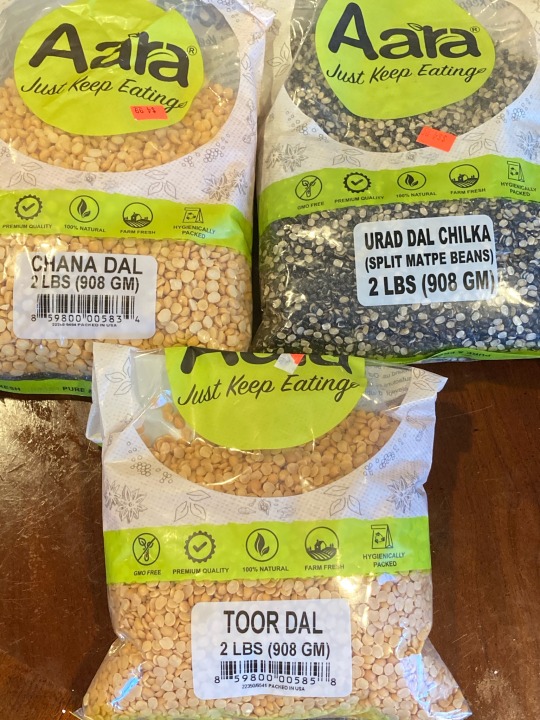
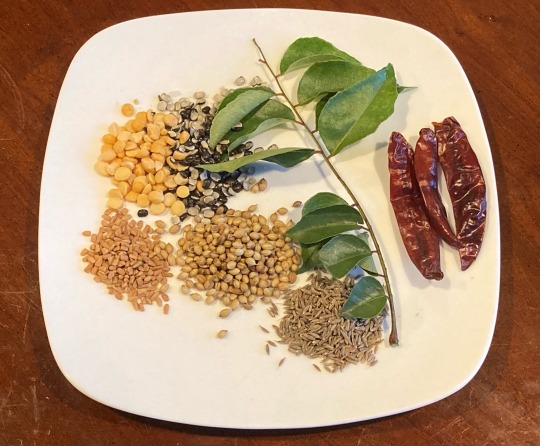
For the tempering / tadka / ಹದಗೊಳಿಸುವ:
2 Tbsp unrefined coconut oil
2 red chilis
8 curry leaves
1 tsp brown mustard seeds / rai / ಸಾಸಿವೆ ಬೀಜಗಳು
Recipes from north Karnataka may add cumin and whole, unpeeled garlic cloves to the tempering.
Instructions:
For the sambar pudi:
1. Break open the coconut and remove and shread its flesh.
If using a whole dried coconut, break into the shell with the wrong side of a hammer and pry open. Break into a few smaller pieces and peel with a vegetable peeler until the skin is removed from the white flesh, wearing something to protect your hand. Soak in warm water for several minutes to soften, and then grate or food process.

2. Heat 2 Tbsp of coconut oil in a skillet on medium-low. Add asafoetida and fry for 30 seconds, until no longer raw-smelling. Add dal and fry, stirring often, for 30 seconds until golden brown; add coriander, mustard, fenugreek, and cumin seeds and fry until fragrant.
3. Add curry leaves and fry until wilted, then add garlic and dried chilis and fry another 30 seconds to a minute, until fragrant.
4. Add coconut and fry, stirring often, for another few minutes until a shade darker. Add turmeric and stir.
5. Grind all ingredients into a paste in a mortar and pestle, then mix in about 1/2 cup water to loosen (if using dried coconut, you may need more water).
Or, put all ingredients along with 1/2 cup water into a blender or food processor and process until a relatively smooth paste forms.
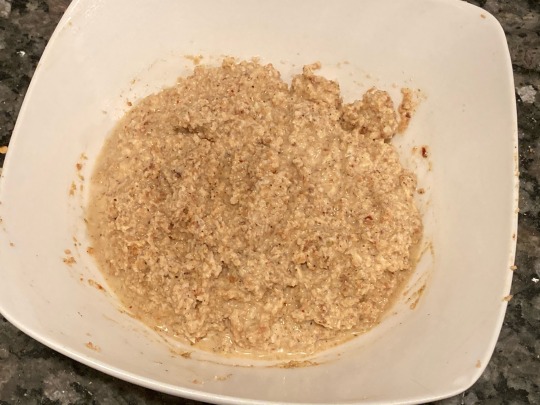
For the sambar:
1. Wash tur dal to remove excess starch. Simmer dal with 2 cups water, 1/4 tsp ground turmeric, and 1 tsp coconut oil for about 30 minutes until very tender. Mash until relatively smooth with a wooden spoon or bean masher, or process briefly with an immersion blender.
You may soak the dal in water after rinsing them to reduce the cooking time, but it is not necessary.
2. Meanwhile, make the tamarind paste. Soak 1 Tbsp tamarind dried pulp in 1/4 cup hot water for 20-30 minutes. Squeeze the tamarind into the water to extract the pulp. Discard the tamarind seeds and husk. Optionally, depending on your preferred texture, push the mixture through a metal sieve.
3. Prepare vegetables. Slice the onion; remove ends of okra and drumsticks and cut into 2-inch pieces; quarter tomatoes; quarter brinjal; peel pumpkin and cut into cubes; peel and cube potatoes.
4. If using onion, add a teaspoon of coconut oil to a large pot and fry until translucent.
5. In the same pot, boil vegetables in just enough water to cover, along with a pinch of salt, until they are beginning to soften.
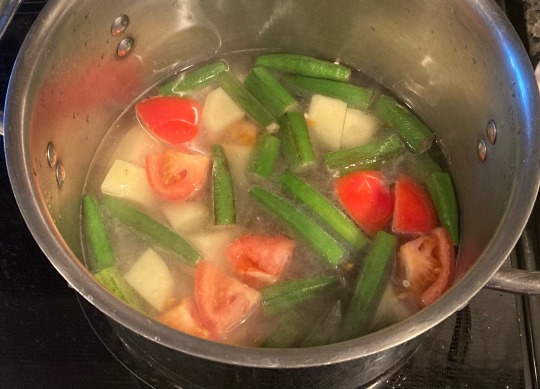
Some recipes call for the vegetables to be boiled, and others call for them to be steamed. I prefer boiling, since it produces a nice savory broth.
6. Mix vegetables, dal, tamarind, jaggery, sambar pudi, and salt to taste and simmer 5-10 minutes to allow flavors to combine and vegetables to cook under tender. Add water as needed. Remove from heat and stir in cilantro. Taste and adjust salt.
The final sambar should be pourable, like a thick soup—Karnataka sambar is typically thinner in consistency than Tamil Nadu versions.
For the tadka:
1. Heat coconut oil in a small skillet on medium heat. Add tempering ingredients and fry, stirring often, until chilis and curry leaves are a couple shades darker and the mixture is fragrant.
2. Pour the oil and tempering ingredients into the sambar and stir in. If you like, retain some of the tadka as a garnish to serve.
3. Serve warm, in individual bowls, alongside long-grain white rice. To eat drumsticks, scoop the center out and eat it; the tough outer rind is left.
If you intend to save some sambar, it's a good idea to make just enough tadka for what you plan to eat that day, and then make fresh tadka to pour over the reheated leftovers.
107 notes
·
View notes
Note
A sandwich.
It contains ice cream, whipped cream, sponge cake, meat balls, broccoli, pineapple, strawberries, tomatoes, lettuce, rice, noodles, mac and cheese, bacon, beef jerky, dried fish, seaweed, one of every Pokemon berry, jam, olive oil, lotus, dragon fruit, ravioli, ramen, tempura, teriyaki chicken, macaroons, escargots, mint, pepper, salt, sugar, croquettes, pickles, apples, avocados, sausages, bell peppers, grapes, pizza, a donut, cheese, more cheese, even more cheese, mushrooms, mustard, olives, a fried egg, a scrambled egg, blueberries, a poached egg, chawanmushi, a red bean bun, mochi, bbq sauce, chicken nuggets, french fries, takoyaki, pancakes, mackerel, salmon, coffee beans, spinach, a tiny bit of corn cream soup, ramensanga, fettucine alfredo, a plain bagel, pretzels, chocolate chip cookies, sweet potato, yam, potato, scallions, scallops, squid, crab stick, fish balls, fish cakes, oyster sauce, silken tofu, barley, cereal, paprika, oysters, red snapper, sea bass, plums, bean sprouts, garlic, string cheese, camembert, swiss cheese, mozzarella, parmesan cheese, yogurt, brinjal, a macdonald’s happy meal (without the toy and the packaging of course), truffles, caviar, tapioca balls, fried chicken, century eggs, cake sprinkles, dark chocolate, milk chocolate, white chocolate, milk tea (just a tinge), coffee (also a tinge), pudding, pumpkin, honey, mutton, mashed potatoes, bananas, icelandic fermented shark that they bury in the ground for months, raisins, dried mangoes, a drop of water, jelly, nata de coco, prunes, roasted pork, rosemary, bee pollen, peas, deer meat, rabbit meat, fish maw, ham, turkey, m&ms, chub, fufu, watermelon, winter melon, rock melon, coffee jelly, cacao, carrots, blueberries, black tea, dumplings, carrot cake, beetroot, purple cabbage, corn, celery, edamame, red beans, black beans, green beans, kidney beans, cashews, peanuts, pecans, sunflower seeds, walnuts, chickpeas, almonds, daikon, MSG, tamales, anchovies, tabbouleh, lions mane mushroom, chicken of the woods, kelp, octopus, durian, kimchi, crème fraîche, popcorn, cotton candy, everything bagel seasoning, capers, pears, marinara sauce, bittercress, butter cream, every single iteration of galarian curry, sushi, sashimi, kale and a very very specific ramen bowl (without the actual bowl) from a very particular shop located in Iwatodai.
And the top and bottom buns are somehow made from 50 different kinds of bread in a checker box pattern.
It comes with a picture.
Ingredients: I am not typing all of that out again. What the fuck.
Smell: You’ve taken an entire food court’s worth of food and made it into a sandwich. This isn’t even possible. Why am I considering this. 3/5
Taste: How do you eat this. 2/5
Texture: You get like 5 different foods every bite. This is not balanced. There is no harmony. This sandwich is the embodiment of disorder and chaos. 1/5
Presentation: The fact that this even looks sandwich adjacent is a fucking miracle. You don’t get full points though. Because I don’t like you. 3/5
Would Chunk Eat It?: He would eat maybe 1/50th of it. So no. 1/5
Final Score: 2/5
Critic’s Notes: Why would you waste this much food. Just host a party. Donate it. Something fucking anything I am begging at this point.
24 notes
·
View notes
